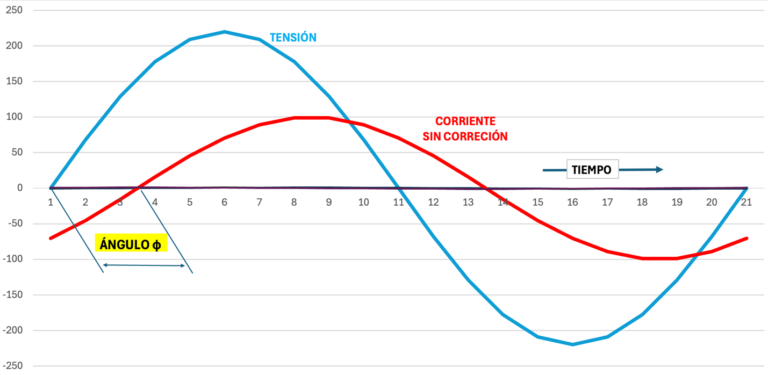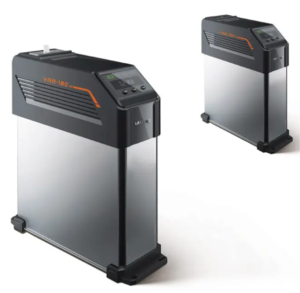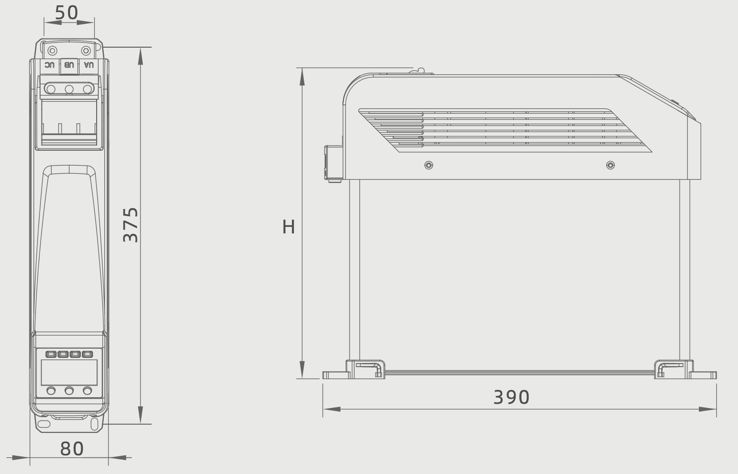Improving Energy Efficiency: Power Factor and ENRE Regulations
The power factor (PF), also known as cos φ, is a key measure to assess the efficiency of the use of electrical energy in facilities and networks. Maintaining an adequate PF allows to minimize losses and avoid damage to the electrical infrastructure, both for the user and the distributors. Given its importance, ENRE has established specific regulations through the “Power Factor Improvement Program”, in order to promote a more efficient use of energy and reduce the circulation of reactive energy that negatively impacts the system. In this context, the measures that users must adopt to comply with the required thresholds and avoid surcharges are detailed.
What is power factor?
The power factor (PF), also called cosine of phi or cos φ, of electrical installations is the mathematical expression of the inevitable physical phenomenon that allows them to function.
If the existence of cos φ is so crucial, why should we worry about it? Because, like so many things, it is beneficial within certain limits, outside of which it also produces inconveniences.
If cos φ measures an unavoidable physical phenomenon, how can it be limited so that it is within values where its advantages can be exploited without harm?
The answer is: by compensating its effects to bring it to values within which it is efficient.
It must be considered that the value of cos φ is entirely dependent on the characteristics of the consumption that the users of the electric service connect to the public network, be it machines, household appliances, lighting, etc., etc.
Before continuing with the regulatory determinations for increasing efficiency, it is appropriate to summarize details of cos φ:
- The power factor/cos φ measures the use of electrical energy.
- The values of cos φ can vary between 0 and 1. The value cos φ =1 is the ideal optimum.
- cos φ relates the active (useful) and inductive reactive powers (the latter not useful)
- The lower the cos φ, the greater the loss of useful energy and the greater the damage to the electrical installations and networks, both of the user and the distributor.
- Increasing the value of cos φ through correction has multiple technical, economic and environmental benefits.
- The cos φ correction is obtained by increasing the capacitive reactive power that counteracts the non-useful inductive reactive power.
- Products that increase cos φ are reactive power compensators. There are electronic ones, which are the most modern, and there are also hybrid and traditional ones. Vaguely but commonly, all cos φ compensators are called capacitors. Such capacitors were the first solution to compensate cos φ since the beginning of the 20th century and this name has managed to last until the present.
Graphical display:
The initial situation is shown in the following graph, which shows the value of the supply voltage and the load current as a function of time when the load is inductive. In this case, the voltage (light blue) goes from zero to positive in period 1, while the current (without correction, red) does the same between periods 3 and 4, lagging the voltage. This phase shift creates an angle φ which gives rise to the power factor when it is defined as a function of its cosine.

In the event that the phase shift of the angle φ is compensated by connecting a capacitive load, it creates a “corrective current” (violet color) that is added to the existing uncorrected current.

The sum of the two currents mentioned gives rise to a single current called the Corrected Current, which is in phase with the voltage, so the angle φ does not exist. In this case, the voltage and the current go from zero to positive values simultaneously, which is the ideal situation for any compensated installation.

What was established regulatoryly in relation to cos φ?
By means of ENRE Resolution 85/2024, published on 02/02/2024, this regulatory body established the “PROGRAM FOR THE IMPROVEMENT OF THE POWER FACTOR”. The initiative aims at the efficient use of electrical energy in the distribution facilities of the concession areas of EDESUR SA and EDENOR SA
Since the date of publication of the aforementioned resolution, the ENRE published other complementary and modifying Resolutions, which are detailed below with their official publication date:
- Res. 222/2024 04/09/2024
- Res. 522/2024 08/02/2024
- Res. 544/2024 08/15/2024
- Res. 628/2024 09/09/2024
Res. 628/2024, which is the most recent, condenses the considerations and determinations currently in force for the development of the “PROGRAM FOR THE IMPROVEMENT OF THE POWER FACTOR”.
What did the ENRE specifically determine?
The penalty for supply installations that have a cos φ less than 0.95 for residential users of rates T1 and T2 (for T3 the tangent magnitude of fi or tan φ is used)
- The objective of the program is to reduce the circulation of inductive reactive energy through the electric power distribution network, which produces negative effects, but can be corrected by correcting the cos φ at the consumption points.
- The ENRE program establishes that users will be penalized:
- Residential T1 and T2 whose cos φ is less than 0.95
- T3 (high demands) whose tan φ is greater than 0.33
All users who do not meet the above thresholds must compensate for the inductive reactive energy consumed in order not to be penalized.
Otherwise, EDENOR and EDESUR may charge a “departure surcharge”.
How are supplies and rates defined by ENRE?
According to ENRE, users are classified as:
- Low demand users: those whose maximum demand is less than 10 kW (kilowatts)
- Medium demand users: those whose average maximum demand for 15 consecutive minutes is equal to or greater than 10 kW (kilowatts) and less than 50 kW (kilowatts)
- High demand users: all others included in A and B.
The rates, according to ENRE:
Referring to users A, B and C defined above, the rates are:
- A Small Demands: based on consumption in kWh
- B and C Medium and large demands based on
- consumption in kWh
- the contracted power in kW
The current complexity of Tariff 1 of the ENRE tariff table for residential users connected to the public network in a single-phase or three-phase manner, deserves a closer look to understand, since it includes a variety of users called:
- Rate 1 – RX (for which X can be from 1 to 6)
- Rate 1 – G are general users, category applies to customers with non-residential end use
- Rate 1 – AP corresponding to Public Lighting
What did the ENRE authorize for cases with cos φ less than 0.95?
- Do not fine supplies to single-phase residential users, regardless of their level of consumption in kWh
- Fine residential users with a three-phase network connection
- Fine users of the 1G rate for general non-residential use
- Fine users of Tariff 1 for public lighting for consumption exceeding 300 kWh every two months.
- Fine T2 and T3 users
If cos φ is less than 0.95, what should the distributor do?
If a user’s meter registers a cos φ less than 0.95, the distributor must inform the user by means of a notification on the invoice with the measured value and grant a period of 60 days to correct it.
If the power factor is not corrected within this period, the distributor is authorized to apply a surcharge to the values of the monthly fixed and variable charge for the energy consumed, increasing them by 1.50% for each hundredth (0.01) or fraction of five thousandths (0.005) of variation in the cosine of cos φ with respect to the reference value of 0.95 in the months in which the calculation of cos φ is outside the acceptable limit.
The amount corresponding to this surcharge must be detailed on the invoice, specifically in the section “Details – Electrical concepts” under the description “Surcharge for departure in cos φ”.
In addition, the value of the resulting cos φ must be stated on the back of your invoice.
Since when do you have to pay a fine?
ENRE established a progressive schedule for the application of fines:
- October 1, 2024: 30% surcharge will be charged.
- May 1, 2025: will increase to 60%.
- December 1, 2025: the surcharge will increase to 100%.
The fine schedule will apply to those with a power factor between 0.85 and 0.95. For those whose power factor is less than 0.85, this schedule will not apply, but rather the fines established according to the current tariff table.
The penalty cap cannot exceed 40% of the net charges on your bill, before taxes.
What is specific to the Horizontal Property regime (*) and cos φ?
- The ENRE resolved that for properties under the Horizontal Property regime (*) within the concession areas of a distributor (**) that have a common general connection that supplies all the co-owner users characterized within the tariff category Tariff 1 (Small Demands) they must install, whenever possible for building reasons, in case it presents a value lower than that established, a unique equipment for automatic correction of cos φ installed in the same property. Such equipment must measure the value of cos φ that is registered at the level of the general connection, and raise it so that the joint demand of all the users of the property is not less than 0.95 (zero point ninety-five). The installation of the corresponding equipment must be notified by the consortium of owners to the distributor.
- In the case of properties under the horizontal property regime of the previous point, the surcharge for low cos φ will be calculated on the sum of the monthly fixed charges and the variable charges, based on the monthly energy consumed and according to their tariff category, of all the co-owner users, including the account of the consortium of co-owners corresponding to the range of the joint cos φ verified in the general connection of the property. This surcharge will be included in the billing of the account of the consortium of co-owners.
- Distributors (**) may charge the “low cost φ surcharge” to properties under the horizontal property or real estate complex regime only from the installation by those meter companies that record active and reactive energy in the common general connection of the property.
- Distributors (**) may not charge any fee for power factor measurement services, determination of compensation volumes, inspections and/or authorizations, and/or installation of meters in the connections of properties under the horizontal property or real estate complex regime, without prejudice to the fact that the provision and installation of compensation equipment will be the responsibility of the consortium of co-owners.
- In the case of properties under the horizontal property or real estate complex regime, the distributors (**) must connect the cos φ correction equipment provided by the obligated party in the event that the facilities to which it is connected are those of the distributor itself. In the event that the facilities to which the equipment is connected are within the user’s area (after a cut-off element that separates the facilities of the user from those of the distributor), the obligated party will be responsible for connecting it.
(*) contemplated in Title V of Book Four of the Civil and Commercial Code of the Nation or Real Estate Complex regulated in Title VI Chapter 1 of the same Code
(**) EDESUR SA and EDENOR SA
Products to compensate cos φ
Electronic compensators
They are the most modern and efficient for achieving savings and ensuring the stability of the electric power grid. They are intended for installations in medium and large-sized buildings, industries, etc.
They significantly reduce costs, eliminate reactive energy penalties and extend the life of the electrical grid.


They are very easy to install and require minimal maintenance. They simultaneously compensate cos φ, eliminate harmonics and compensate phase imbalance.
Smart Capacitors
They reduce losses, improve power factor and energy quality.
They integrate modern measurement and control, power electronics, network communication, automation control and power capacitors.


Own protection function against: over voltage, low voltage, short circuit, over current, over harmonics and over temperature.
We hope that this review will be useful to the reader in identifying the basic elements in relation to the power factor, the need to reduce it through compensation and the regulations that ENRE has issued in this regard throughout 2024.
Engs. Carlos Chababo and Jorge Rivadulla
Director
EFFISNE
www.effisine.com
e-mail: consultas@effisine.com
WA: +54 911 2728 5562
